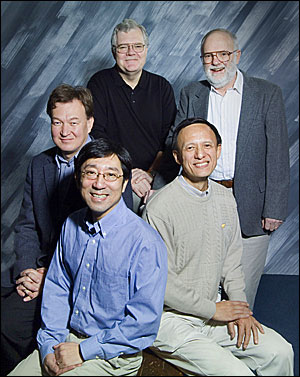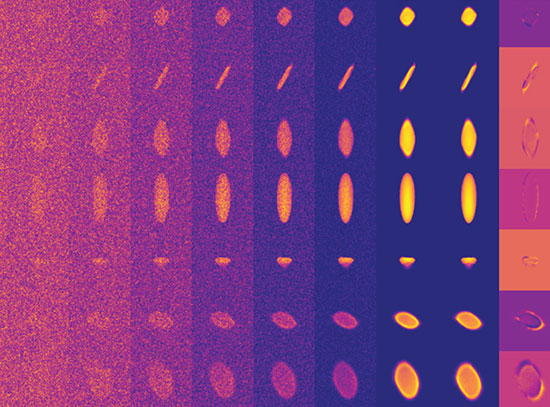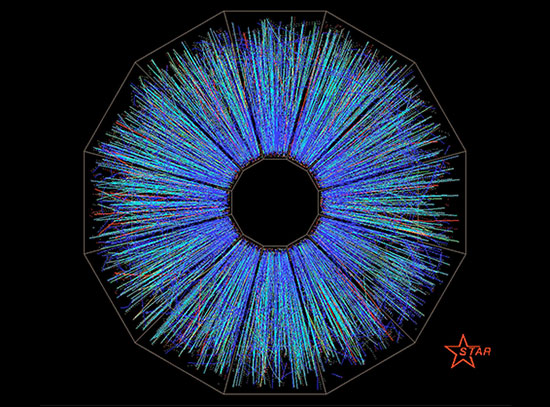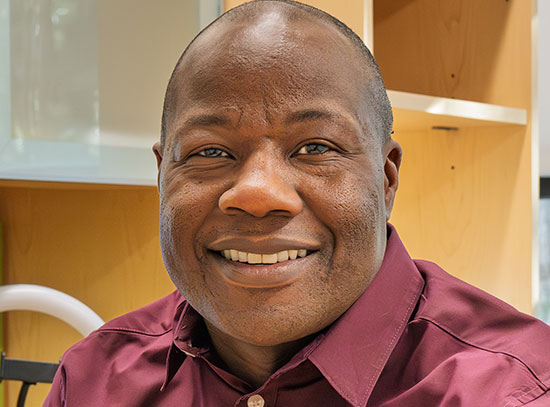Five Brookhaven Lab Scientists Named American Physical Society Fellows
December 28, 2006
UPTON, NY - Five scientists at the U.S. Department of Energy's (DOE) Brookhaven National Laboratory - Tim Hallman, Chi-Chang Kao, Dmitri Kharzeev, William Morse, and Yimei Zhu - have been named Fellows of the American Physical Society (APS), a professional organization with more than 45,000 members. Election to APS Fellowship is limited to no more than one half of one percent of its membership in a given year, and election for this honor indicates recognition by scientific peers for outstanding contributions to physics. The Brookhaven scientists are among 212 Fellows elected in 2006.
 enlarge
enlarge
Clockwise from left, Dmitri Kharzeev, Tim Hallman, William Morse, Yimei Zhu, and Chi-Chang Kao. (Click image to download hi-res version.)
Hallman, a senior physicist, was recognized "For his leadership of the STAR experiment at the Relativistic Heavy Ion Collider at Brookhaven National Laboratory." Since 2002, Hallman has served as spokesperson for the STAR experiment at the Relativistic Heavy Ion Collider (RHIC), a world-class scientific research facility that drives two intersecting beams of gold ions head-on to study the early universe. At RHIC, the STAR detector searches for quark-gluon plasma (QGP), the type of matter postulated to have existed just microseconds after the Big Bang.
Hallman earned his Ph.D. in physics from The Johns Hopkins University in 1982. After working as a postdoctoral and associate research scientist at the university, he joined DOE's Lawrence Berkeley National Laboratory in 1991 as a staff scientist. Later that year, he accepted a research physicist position at the University of California. Hallman joined Brookhaven as a physicist in 1996. He is currently the STAR Group Leader.
Kao, Chair of Brookhaven's National Synchrotron Light Source (NSLS) Department, was recognized "For his many contributions to resonant elastic and inelastic x-ray scattering techniques and their application to materials physics." During his research at the NSLS, Kao has developed new x-ray scattering techniques to study the electronic and magnetic properties of magnetic and strongly correlated materials. These techniques have led to better understanding of the Earth's interior and materials properties under extreme conditions.
Kao earned his Ph.D. in chemical engineering from Cornell University in 1988. Shortly after, he joined BNL as a postdoctoral research assistant at the NSLS. He was promoted to senior physicist in 2001. Kao is also an adjunct professor in the Department of Physics and Astronomy at Stony Brook University.
Kharzeev, a physicist and leader of Brookhaven's Nuclear Theory Group, was recognized "For research on the properties of matter at very high energy densities, and the theory of the high-energy limit of QCD." Kharzeev's work at BNL focuses on quantum chromodynamics (QCD), a theory that describes the interactions of subatomic particles. Working with data from particle collisions at RHIC, Kharzeev's group probes QGP, the type of matter expected to have existed at the first millionth of a second after the Big Bang.
Kharzeev received his Ph.D. in physics from Moscow State University in 1990 and joined Brookhaven in 1997 after holding positions at the National Institute of Nuclear Physics, Pavia, Italy; the Theory Division at CERN, the European laboratory for particle physics; and Bielefeld University, Germany. He was promoted to senior scientist in 2006.
Morse was recognized "For leadership and intellectual contributions to experimental particle physics, and especially for his role as resident spokesman for the BNL muon anomalous magnetic moment experiment." The Muon (g-2) Experiment was a project at BNL's Alternating Gradient Synchrotron (AGS) that investigated how the spin of a muon is affected as this type of subatomic particle moves through a magnetic field. The experiment's findings challenged the so-called Standard Model of particle physics, a theory that describes the fundamental structure of matter. Morse was the resident spokesman of the experiment from 1991-2004.
Morse earned his Ph.D. in physics from Purdue University in 1976 and joined the BNL physics department immediately after. From 1985 to 1991, he was the co-spokesman with Yale professor Michael Schmidt for the AGS E845 experiment, which searched for the rare decay of an unstable particle called a kaon.
Zhu, the Director of BNL's Institute for Advanced Electron Microscopy and Group Leader for the Center for Functional Nanomaterials, was recognized "For outstanding and innovative development and implementation of advanced electron beam experiments to understand electronic and magnetic structures and the physical behavior of functional materials such as superconductors and ferromagnetics." Zhu's work includes assessing the properties of materials that may lead to magneto-electronic devices on the scale of billionths of a meter for use in applications ranging from digital communication to data storage. His group performs this research using state-of-the-art electron microscopes that can magnify a sample up to 50 million times its size.
Zhu received his Ph.D. from Nagoya University, Japan, in 1987. After working at the University of Virginia as a research associate, he joined Brookhaven in 1988 and was promoted to senior scientist in 2002. He is an adjunct professor at Columbia University's Department of Applied Physics and Mathematics and Stony Brook University's Department of Physics and Astronomy and Department of Materials Science and Engineering.
Note to local editors: Tim Hallman lives in Wading River, NY; Chi-Chang Kao resides in Setauket, NY; Dmitri Kharzeev is a resident of Port Jefferson, NY; William Morse lives in East Patchogue, NY; and Yimei Zhu resides in Stony Brook, NY.
2006-10573 | INT/EXT | Newsroom









